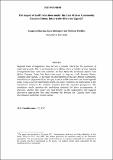| dc.contributor.author | Khorana, Sangeeta | |
| dc.contributor.author | Kimbugwe, Kato | |
| dc.contributor.author | Perdikis, Nicholas | |
| dc.date.accessioned | 2021-09-21T10:29:15Z | |
| dc.date.available | 2021-09-21T10:29:15Z | |
| dc.date.issued | 2009 | |
| dc.identifier.uri | http://hdl.handle.net/11671/24252 | |
| dc.description | Pgs. 27, with tables, includes bibliographic references | en |
| dc.description.abstract | Regional trade arrangements have become a popular vehicle for the promotion of trade and growth. This is particularly so in Africa where a number of over lapping arrangements have come into existence. In East Africa the previously defunct East Africa Customs Union has been resurrected to improve trade between Kenya, Tanzania and Uganda. To facilitate the development of the East African Community, transitional arrangements have been put in place to liberalise inter and intra-regional trade. Using a partial equilibrium model, this paper examines the implications of the transitional measures for products sensitive from the Ugandan perspective. The simulation results question the underlying rationale for these arrangements. It discusses whether they confer any real benefits on the stakeholders and suggests alternative approaches that may increase the benefits for Uganda from trade liberalisation within the customs union. | en |
| dc.language.iso | en | en |
| dc.publisher | Aberystwyth University | en |
| dc.subject | Customs Union | en |
| dc.subject | Regional Integration | en |
| dc.subject | Tariffs | en |
| dc.title | The impact of tariff reductions under the East African Community Customs Union: Intra-trade effects on Uganda∗ | en |
| dc.type | Article | en |

